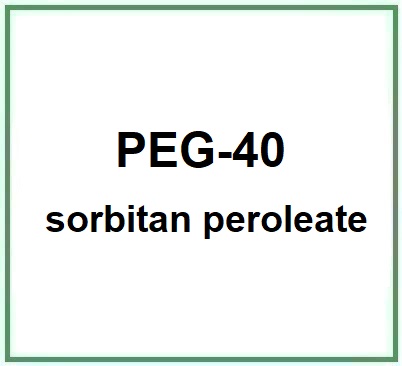PEG-40 Sorbitan Peroleate is a chemical compound, a synthetic emulsifier widely used in skincare and haircare products.
The name describes the structure of the molecule:
- PEG-40 refers to a polyethylene glycol with a specific average molecular weight. PEG (Polyethylene glycol) polymerize condensed ethylene oxide and water and are referred to as polyethylene glycols, but they are actually complex chemical components, polymers bonded together. For example, plastic is polyethylene and has a hard consistency, while polyethylene aggregated with glycol forms a liquid. PEGylation is produced not only as heterification but also as transesterification, which is the transformation of an alcohol by an ester.
The number that appears after the abbreviation PEG represents the molecular weight, and the higher this number is, the less it penetrates the skin.
The term 'eth' refers to the ethoxylation reaction with ethylene oxide after which residues of ethylene oxide and 1,4-dioxane (1), chemical compounds considered carcinogenic, may remain. The degree of safety therefore depends on the degree of purity of the compound obtained. No manufacturer appears to provide this information on the label, at least as of the date of this review.
- Sorbitan is derived from sorbitol, a sugar alcohol. It is commonly used as an emulsifier in cosmetic formulations, helping to mix oil-based and water-based ingredients.
- Peroleate refers to esters formed from oleic acid, a fatty acid. Esters like peroleate are known for their emollient properties and for helping to form thin films on skin and hair.
Chemical Industrial Synthesis Process
- Reagent selection. Production begins with the selection of sorbitan (derived from the dehydration of sorbitol) and oleic acid as the main raw materials.
- Esterification. Sorbitan is reacted with oleic acid to form sorbitan oleate, an ester used as the basis for further reactions.
- Ethoxylation. Sorbitan oleate is then treated with ethylene oxide to add polyoxyethylene groups, increasing the water solubility of the compound. The number "40" in PEG-40 indicates the approximate number of ethylene oxide units added.
- Purification. After the reaction, the product is purified to remove impurities and unwanted by-products. This may include techniques like vacuum distillation or filtration.
- Quality control. The final product undergoes various quality control tests to ensure it meets the specific standards required for use in cosmetic products, including tests for purity, safety, and stability.
What it is used for and where
It serves to stabilize emulsions, promoting the mixing of oily and watery components in cosmetic products. This ingredient helps improve the spreadability of the product on the skin and hair, also providing a feeling of softness. It is particularly useful in formulations that require good spreadability and uniformity, such as lotions, sunscreens, and hair care products.
Cosmetics - INCI Functions
Surfactant - Emulsifying agent. Emulsions are thermodynamically unstable and are used to soothe or soften the skin and emulsify, so they need a specific, stabilising ingredient. This ingredient forms a film, lowers the surface tension and makes two immiscible liquids miscible. A very important factor affecting the stability of the emulsion is the amount of the emulsifying agent. Emulsifiers have the property of reducing the oil/water or water/oil interfacial tension, improving the stability of the emulsion and also directly influencing the stability, sensory properties and surface tension of sunscreens by modulating the filmometric performance.
Surfactant - Cleansing agent. Cosmetic products used to cleanse the skin utilise the surface-active action that produces a lowering of the surface tension of the stratum corneum, facilitating the removal of dirt and impurities.
Main uses of PEG-40 Sorbitan Peroleate.
Effective Emulsifier. It helps stabilize and maintain homogeneity in emulsions, preventing the separation of oil-based and water-based ingredients in cosmetic products such as creams and lotions.
Oil Solubilizer. It facilitates the solubilization of essential oils and fragrances in water-based formulations, improving the uniform distribution of these components in the final products.
Product Texture Improvement. It contributes to a smoother and more uniform texture in cosmetic products, making application more enjoyable for the user.
Versatility. It can be used in a wide range of cosmetic products, including serums, creams, lotions, cleansers, and bath products.
Skin Compatibility. Generally well tolerated by the skin, it helps to create formulas that are both effective and pleasant to the touch.
Formulation Stability. It enhances the stability of cosmetic formulations, ensuring that they retain their beneficial properties over time.
References_____________________________________________________________________
(1) Kim MC, Park SY, Kwon SY, Kim YK, Kim YI, Seo YS, Cho SM, Shin EC, Mok JH, Lee YB. Application of Static Headspace GC-MS Method for Selective 1,4-Dioxane Detection in Food Additives. Foods. 2023 Sep 2;12(17):3299. doi: 10.3390/foods12173299.
Abstract. Efficient detection methods must be developed for 1,4-dioxane due to its suspected status as a human carcinogen, which is highly mobile in food and environmental resources. In this regard, this experiment has been conducted to develop reliable and selective detection and measurement methods by using static headspace (SH) isolation, followed by gas chromatography-mass spectrometry (GC-MS). A new method was developed for determining the spiked 1,4-dioxane contents in a polyethylene glycol 600 (PEG 600). The optimal condition for SH-GC-MS was discussed. The representative ions of 1,4-dioxane and 1,4-dioxane-d8 in the SIM mode of MS are 88 and 96, respectively, and the peaks of the SIM mode were separated and confirmed. The linear range for the method covers 0.25 to 100 mg/L with a coefficient of determination (R2) ≥ 0.999. The method applicability was demonstrated by spike recovery across a variety of food additives (i.e., chlorine bitartrate, choline chloride, polysorbate 20 and 60, and PEG 1000). All spike recovery from the tested samples was in the range of 89.50-102.68% with a precision of 0.44-11.22%. These findings suggest a new analytical method for food safety inspection, and could be applicable for ensuring the safety of foods and environmental and public health on a broad scale.
![]() PEG-40 sorbitan peroleate
PEG-40 sorbitan peroleate 

